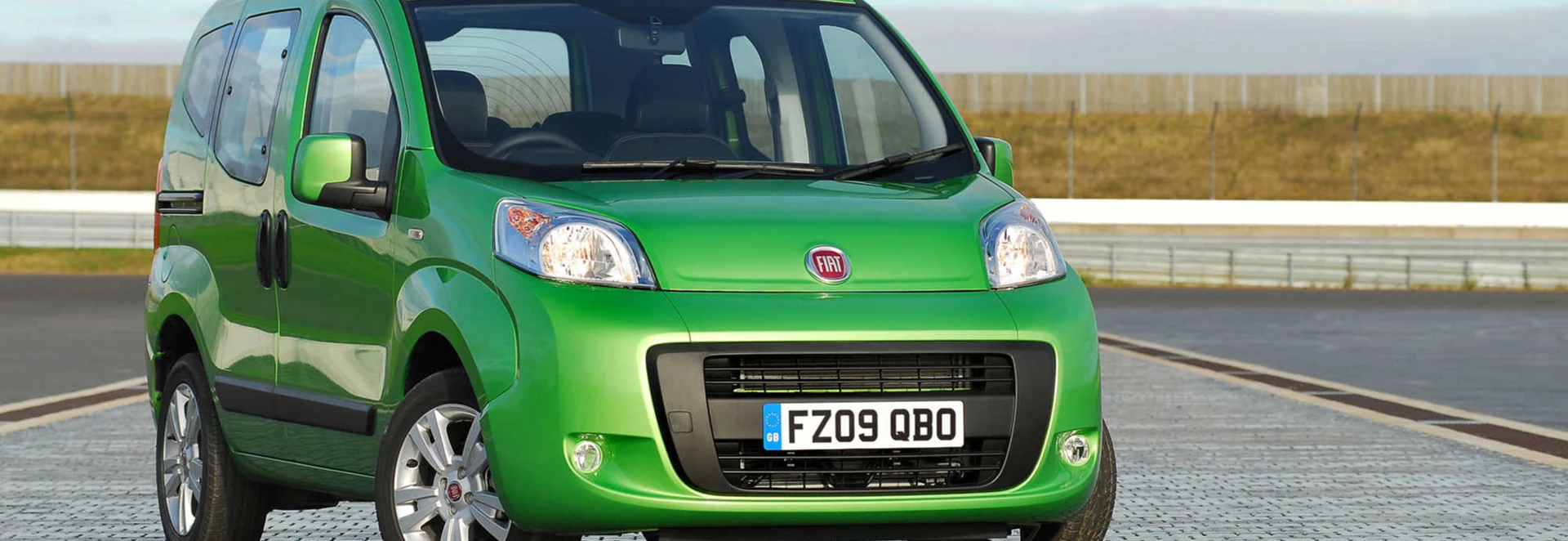Based on the Punto platform, the Fiat Qubo is a van-based compact MPV built in Turkey by Tofas, which also played a part in its development. It's a lot more basic than a car-based equivalent such as the Citroen C3 Picasso, but makes up for that to a large extent by being considerably cheaper.
The Qubo is offered with a 76bhp 1.4-litre petrol engine and two 1.3-litre MultiJet diesels producing 74bhp and 94bhp. From the car's launch in early 2009 there have been two trim levels called Active and MyLife, while later the same year Fiat introduced another version called the Trekking, which has slightly more off-road capability. Dualogic semi-automatic transmission is available as an option on the MultiJet models.
Performance
If straight line performance were of any importance the Qubo would be a bit of a disaster with its low-powered engines and un-aerodynamic shape. The petrol car takes 14.7 seconds to get from 0-62mph and has a top speed of 96mph, while the 74bhp MultiJet has the same maximum but takes longer to get there, being half a second slower when covering the benchmark 0-62mph sprint.
By comparison, the 94bhp MultiJet Qubo is quite the hot hatch, covering the benchmark sprint in 12.2 seconds and continuing to 107mph. This is probably the one to go for if you're planning to use the car for a lot of out-of-town journeys, but for urban use the others are quick enough.
Refinement isn't a big part of the Qubo's appeal, but if it matters to you the petrol car is considerable quieter than either of the diesels.
Ride and Handling
The van-like driving position gives you a good idea of what's going on, and although the high centre of gravity isn't dynamically ideal you can tackle corners in a spirited manner without torturing the tyres.
Partly because it doesn't have enough power to get into trouble, the Qubo is good fun to drive. The van-like driving position gives you a good idea of what's going on, and although the high centre of gravity isn't dynamically ideal you can tackle corners in a spirited manner without torturing the tyres. There's obviously a limit to how far you can go with this, of course, and boy racer tactics are not advised. At reasonable speeds, though, the Qubo is quite entertaining. It also rides well, absorbing back-road bumps quite effectively. The Trekking rides 20mm higher than the Active and MyLife and has extra body protection, Pirelli "mud and snow" tyres and a system called Traction+ which reduces wheelspin. It doesn't have four-wheel drive and is not a serious off-roader, but it can cope with conditions that would bring either of the other versions to a standstill.
Interior and Equipment
The Qubo is also sold as the Citroen Nemo and the Peugeot Bipper. But at heart it's a Fiat.
With the rear seats and parcel shelf in place, the Qubo has a luggage capacity of 330 litres, which is less than you get in most medium-sized family hatchbacks. The situation changes entirely if you fold down the seats and are prepared to load the car to roof level, which opens up the available space to 2500 litres. There isn't a hatchback in the world that can match that. The reason for all this volume is that the Qubo is a tall car, though not a particularly long or wide one. Its shape dictates what you can reasonably put in it - stacking up a lot of small items isn't going to work because they'll start falling over as soon as you drive off. The Qubo is better at carrying one or two much larger objects, and you can fit them in fairly easily thanks to the large tailgate (or twin doors which you can have as a £115 option) and the sliding rear side doors. The Active is quite basic and is not fitted as standard with the alloy wheels, air-conditioning, Blue&Me TomTom connectivity or foglights that you get on the MyLife, though you can have them as optional extras. Roof bars, tinted rear windows, a luggage retaining net and a full-sized spare wheel are all available on the Trekking, and again can be specified on the other cars at extra cost. Several other features are optional on all versions, the most important of them being an alarm.
Cost
As well as being rather slow, the petrol car will cost more than the diesels in fuel and tax.
Qubo list prices start at a little under £12,000 and never exceed £16,000, though you can easily spend more than that on a 94bhp Trekking if you load it with extras. Diesel cars are, as usual, more expensive than petrol ones but cheaper to run, with official combined fuel economy in each case of 68.9mpg (though you'd be doing well to get within 20mpg of that) and a CO2 rating of just 107g/km, which means annual Vehicle Excise Duty payments of £20. As well as being rather slow, the petrol car will cost more than the diesels in fuel and tax. Combined fuel economy is 40.9mpg (the urban figure being just 31.7mpg) and the 161g/km CO2 emissions oblige you to pay £180 per year in VED. Nevertheless, it may still be the best option if you don't envisage doing many long journeys.
Our Verdict
The Qubo is a piece of nonsense if you don't need a car like this but a very tempting choice if you do. It’s worth considering if you interesting in buying a family car that’s compact yet offers plenty of headroom. It's good to drive, no faster than it needs to be and very practical in certain circumstances. And while the van heritage may put some people off, it actually makes the Qubo ideal for the job it was designed for.




